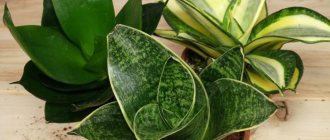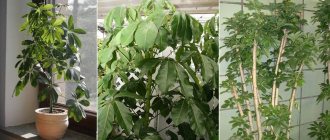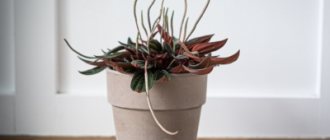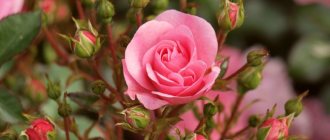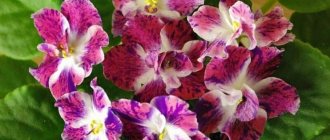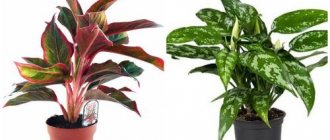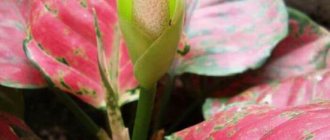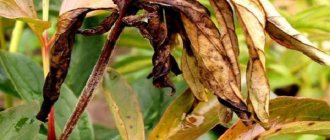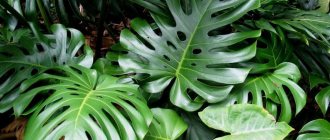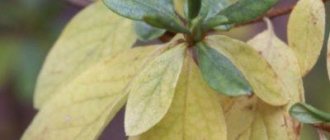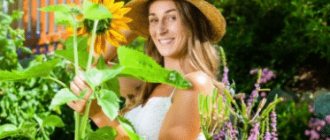Description
Sansevieria moonshine (sansevieria) has the Latin name Moonshine and belongs to the Agave family. Moonshine – translated as “silver moon” , this description corresponds to the color of the leaves of this flower. Among gardeners, the plant is also called “pike tail” (a collective name for all types of sansevieria) or “snake skin”. You can learn more about Sansevieria species here.
Moonshine is a perennial, evergreen plant. Its leaves are dense, erect, and pale green in color. A distinctive feature is a bluish-silver tint. The stem is missing. The leaves appear immediately from the rosette, curl at its base and tend upward. Their width reaches 5-6 cm, and their height is about 30 cm. The flowers are white, collected in miniature panicles. The diameter of the rosette rarely exceeds 12 cm, and the height is 35 cm.
Reference! The habitat of wild Sansevieria Moonshine is the subtropical zones of Africa, India and Madagascar.
Sansevieria propagation
If the time to plant mother-in-law's tongue was in the spring, you can combine this procedure with propagation. During this period, all biological processes are proceeding at an accelerated pace; the active movement of juices will help the plant take root faster.
Novice gardeners are interested in the question of how Sansevieria reproduces. This activity is carried out in several ways:
- division of rhizomes;
- cutting off side shoots;
- fragments of a leaf plate.
The latter option does not allow preserving the color of some types of pike tail, but the method still remains popular. This method is especially good if the root system has become sick and unusable.
Preparing for transplant
Leaf
You can also use the propagation of Sansevieria by leaf in the case when an already formed plate breaks off. At the same time, mother-in-law’s tongue can be rooted both in the soil and in a cylindrical container with water.
The soil
In order for Sansevieria to take root, propagation by leaf is carried out in a soil other than that intended for replanting the flower. In this case, the loose substrate should contain components in the following proportion:
- 1 part of sand and humus;
- 2 parts each of turf and leaf soil;
- The presence of charcoal is required.
Another composition is also suitable for propagation: from leaf and turf soil with the addition of perlite (all ingredients are taken in equal parts). The soil must be sterile (calcined) and moist before planting.
What kind of pot do you need?
The rules for choosing a container for a pike tail were mentioned above. The cuttings with which the plant will be propagated are small in size. Therefore, you should not take a spacious pot. For starters, a container no more than 8 cm in diameter and about 5-6 cm deep is quite suitable.
As for the material of the pot, it must be breathable so that future roots can breathe. Ceramics (clay) are best suited for this. In addition, it perfectly absorbs water, acting as additional drainage.
Agricultural technology
To know how to properly propagate sansevieria by leaf, follow the step-by-step instructions. At the same time, despite the general aspects, there are differences in earth and water rooting.
Leaf propagation
First perform the following actions:
cut a healthy, undamaged leaf from the mother bush; the plate is cut into strips of 10-15 cm, moving with a sharp knife perpendicular to the veins; On each fragment, the bottom and top are marked with a marker (this is important when planting).
Important! If part of the plate is buried in the ground or lowered into water with the wrong cut (against the flow of juices), you may not expect roots. Peculiarities of propagation of Sansevieria by leaf
Peculiarities of propagation of Sansevieria by leaf
| In the ground | In water |
|
|
Planting leaf parts directly into the substrate is preferable - rooting will occur faster (in 1.5-2 months). New shoots from the leaf can be expected in 7-8 months. For this to happen, optimal conditions are maintained:
- air temperature – within 21-25°;
- luminous flux - only diffused;
- substrate – moderately moistened (watering through a tray).
Note! When propagated by leaves of mother-in-law's tongue, some gardeners practice the greenhouse effect. It is undesirable to do this - due to high humidity, the cuttings may rot
Why remove the growing point of Sansevieria?
The goal of propagation is not just to get a new plant, but also to preserve all its characteristics. Not every method satisfies this desire. In varieties with variegated leaves, color can only be preserved by propagation by layering.
The older the plant, the less likely it is to get planting material from it. After 5 years, the flower practically does not form root layers. To stimulate the queen cell to develop, you need to carefully cut out (not twist) the growth point and remove the top 2-3 leaves.
Sansevieria with layerings
The plant will immediately redirect its forces to the development of the rhizome; after 1.5 months, several good layering will develop on the bush. They are cut off and planted in pots. After this, an adult Sansevieria can grow for several more years (until the foliage dies).
Photo
Below you can see a photo of the plant:
Varieties of Hanii (Hahnii)
and here are my hanky again (large):
SvitLana The second is very similar to my Favorite with reverse variegation
It is immediately visible in the pile
Well, I don’t know, everything is clear with mine so far:
From left to right, top row: Crosbys Marginata, Yellow Stripe, Silver Honey. From left to right, bottom row: Jade Marginata, Golden Banner, Honey Gold
Svetlana, the first and last ones look like S.Hahnii marginata, that is, an ordinary marginata
tigridia and your Yellow stripe from the same song.
Here is my usual marginata, the more light there is, the squat and the wider the stripes. Stretches out in the dark
Well, she is my favorite.
the first and 4th are Marginata, and Golden Honey is the 3rd. With the last one everything is clear. but Favorite and Marginata came into question. after I read this thread.
SvitLana this is all a thankless task. The conditions of detention change Sansa beyond recognition. Although, of course, some signs remain.
Here is my sansa S.Hahnii Gild Edge
the first leaves standing in the light retain the characteristics of the variety, then I put it away on another windowsill and the new leaves are different. Without the old ones you won’t recognize
but here they are generally hardly recognizable. although if you put them in the light, everything will come back
How to care at home?
Sansevieria Moonshine is unpretentious and does not require special attention or special conditions for growing. In order for the leaves to be dense and not lose their characteristic color, you must adhere to the following care rules.
Temperature
Sansevieria is unpretentious to temperature increases; it grows well in the range from +18 to + 35°C. But when it drops below +15 °C, the plant will first lose its characteristic color, and then may even die.
Watering
The main condition is regularity, without excessive drying out or waterlogging of the soil.
During the winter months, the frequency of watering is reduced as the temperature drops , down to an interval of 2-3 weeks. In summer, the frequency reaches 1-2 times a week.
The water should be settled and at room temperature. In all seasons, the foliage must be wiped with a damp sponge at least once a week, avoiding moisture getting into the outlet.
Light mode
Sansevieria prefers a well-lit place , without direct sunlight. Summer afternoon sun can leave burns on its leaves.
Attention! With insufficient lighting, plants slow down and the leaves become dark green without a bluish tint.
Priming
For planting, universal soil is suitable, additionally enriched with loosening components:
- perlite;
- pebbles;
- fine expanded clay.
To make your own soil you will need:
- leaf soil - 1 part;
- sand – 1 part;
- turf soil - 2 parts.
Pot
Sansevieria is very elongated, so for stability it will need a low but wide pot. Its diameter should be approximately twice the height. The powerful roots of Sansevieria can easily deform or even break a thin plastic pot. Preference should be given to thick-walled ceramic options.
Transfer
Due to its slow growth, the plant does not require frequent replanting . A sign of its need is the appearance of roots from the drainage holes at the bottom of the pot.
The optimal time for the procedure is late spring-early summer.
Step-by-step instructions for transplanting Sansevieria:
- Pour at least 1.5-2 cm of drainage into the bottom of the new pot. Its role can be small pebbles or expanded clay.
- Pour soil on top, the thickness of the layer depends on the height of the pot (but not less than 2 cm).
- Place the flower and distribute the root system throughout the pot.
- Fill with soil to the edge of the pot. Press lightly with your hand and pour generously.
Fertilizing
Mineral fertilizers for indoor plants or succulents are suitable for Sansevieria Moonshine . It is more convenient to use fertilizer in liquid form. The application period is from March to September. Before use, the fertilizer must be diluted twice as much as indicated in the instructions. Fertilize no more than once every two weeks.
Trimming
To perform pruning, you only need well-sharpened scissors. Execution algorithm:
- Remove all yellowed, rotted or dried leaves.
- Trim the dried ends, not retreating more than 1 cm from the edge of the sheet.
- Treat the cuts with crushed coal.
Important! Pruning is performed only to remove dried foliage; the plant does not need shaping.
Wintering
In anticipation of the winter months, it is necessary to gradually reduce watering to once every 2-3 weeks. The temperature should not drop below +15 °C; prolonged exposure to open windows or vents should be avoided. To preserve the color of Sansevieria Moonshine, additional lighting is required during the winter months.
Features of reproduction
You can get a young plant in two ways:
- By dividing the rhizome .
In spring, remove the mother plant from the pot and divide its rhizome into several parts. Each of them must have at least one growth point. Plant in new pots, place in a warm place and water moderately. Rooting time is 1-1.5 months. - Side shoots . During transplantation, separate the already formed young shoots and plant them in new containers. It will also take about a month for complete rooting.
Important! When using the leaf propagation method, loss of the decorative qualities of the plant, in particular the color of the shoots, is possible. Therefore, preference should be given to dividing the rhizome and side shoots.
Landing
Aloe vera flower: description, features of care and cultivation, medicinal properties, photo
Ceramic container, wide and shallow, drainage hole
A drainage layer must be placed at the bottom of the planting container: small pebbles, expanded clay, broken bricks with pieces of charcoal. This layer should be thicker the younger the plant and can fill up to a third of the volume of the pot.
When planting, pay special attention to the preservation of the root system, trying to preserve the earthen ball. Transfer
Transfer
Sansevieria hanni are replanted in the spring, in March-April. The signal for replanting is the complete entanglement of the soil with roots. Young plants give such a “signal” annually, more mature ones – once every 2-3 years.
Before transplanting, stop watering, plant in moist soil, and do not water immediately after transplanting.
In summer, it is enough to water Sansevieria hanni once a week, and in winter - once a month. This is exactly the case when it is better to dry it than to over-moisten it.
Deciduous plants are especially protected from the ingress of irrigation water: stagnation of moisture in it leads to root rot, which will destroy the plant.
Dry air is preferable; spraying is not necessary; you just need to periodically wipe off the dust from the leaves.
Top dressing
During the period of active growth of sansevieria, in spring and summer, fertilizing is carried out once every two weeks with a specialized mixture for cacti and succulents.
If complex fertilizers are used, you need to take into account that they should not contain an excess of nitrogen compounds and this complex must be dissolved in a much larger amount of water than for other plants.
Trimming
This operation is applied only to damaged leaves. They usually dry out and then such an area should be cut off, leaving a narrow dry border so that the process stops.
Bloom
Sansevieria hanni can bloom at any time of the year - with small star-shaped flowers on an elegant peduncle. This peduncle needs to be trimmed after flowering.
To encourage the plant to flower, it is transplanted into a tight pot, only 4-5 cm wider than the previous one.
Diseases and pests
The main pests of this variety are:
- Spider mite . The leaves turn yellow and white spots appear on them. For prevention, wiping with a damp sponge is used; for treatment, the insectoacaricide Actellik is used.
- Thrips . The leaf blade becomes grayish-brown, and eggs laid by the pest are visible on the underside. Insecticides are used for treatment.
- Mealybug . The foliage becomes distorted, turns yellow and dies. If the pest colony is small, it can be removed by wiping the leaves with a damp cloth. In case of severe damage, karbofos is used.
The most common diseases and care errors are:
- Brown spots and dried areas are symptoms of anthracnose. The disease develops due to waterlogging and is treated with a fungicide solution.
- Yellowness and softening of the leaves at the base is another sign of waterlogging. All affected shoots must be removed and the plant transplanted into fresh soil.
- Uniformly withered leaves and their death may indicate an excessive drop in temperature and dry soil. Sansevieria must be moved to a warm place and all damaged areas removed.
Varietal diversity
After the main subspecies was developed through selection, several other varieties were obtained. Their differences lie in the color of the leaf plates.
- Sansevieria Hanni Cristata retains its characteristic pockmarked coloration. But the leaf plates are wrapped on both sides towards the center, almost folding in half.
- Sansevieria Honey Gold is one of the most popular varieties. A variegated form that stands out among other varieties with longitudinal stripes of a golden hue. In Sansevieria Hanni Golden, the colored strokes are located unevenly, which only adds to its decorativeness along with the yellow border.
- Silver Hunny differs from the main variety in the color of its leaf blades. Instead of green, silvery-gray shades are expressed. The transverse stripes are clearly visible.
- Sansevieria Hanni Lucille Polan is similar to the Golden variety: it also has wide longitudinal stripes of a yellowish color, only a little lighter. In addition, the leaf plates are rolled inward a little more, giving a boat shape.
Similar flowers
Other representatives of this genus are most similar to Sansevieria Moonshine:
- Cylindrical.
- Futura.
- Bacularis.
- Black Coral.
- Laurenti.
Did you know that sansevieria purify indoor air from toxic substances such as formaldehyde and nitric oxide? To successfully grow this flower, we recommend reading our articles about three-strip, Velvet touch and Hanny.
Sansevieria Moonshine is a beautiful and unpretentious houseplant that is suitable not only for beginner gardeners, but will also add to the collection of experienced indoor plant lovers.
Why do Sansevieria leaves gradually dry out, curl and fall off?
A room thermometer and the state of the earthen ball in the plant’s pot will help you understand why the leaves of Sansevieria are gradually falling. If the temperature is too low (below 12 °C) and the soil is too wet, similar symptoms may appear. If health measures are not taken in time, rot may occur and the condition of the leaves may deteriorate. They will become watery and soft. Therefore, if sansevieria leaves gradually fall off, first of all it is necessary to increase the air temperature in the room, reduce watering to a minimum and, if necessary, remove damaged leaves. Perhaps the shoots sink to the ground under their own weight.
If the leaves of Sansevieria gradually curl, then most likely the plant does not have enough moisture. Just water it a little and wipe the sheets with a damp sponge. During the period of germination of young shoots, this phenomenon can also be observed, but in this situation it does not last long, and the leaves restore their shape.
You can also understand why Sansevieria leaves curl en masse based on the last transplant of the plant. If this happened very recently, then most likely the plant simply has not adapted yet. Or, on the contrary, the soil is too old and does not contain the nutrients necessary for a growing organism. In the first case, it is enough to create partial shade and warmth for the plant - and after 1-2 weeks it will get used to it. In the second case, you should simply replant it in a fresh nutrient substrate.
The appearance of various spots on the leaves of Sansevieria may be a sign of improper care or a fungal disease. Dark spots indicate that the plant does not have enough natural diffused light. Red-brown, yellow and brown local colors indicate that the flower is over-watered or that fungal spores have appeared.
If the leaves of Sansevieria gradually dry out, then perhaps it was exposed to scorching direct sunlight, which caused burns and dryness of the leaf plate. It is possible that this unfavorable process began with too little or too much watering. Do not hesitate to inspect the root system, because it is possible that the pot has become too cramped and the roots have nowhere to go. In this case, it is enough to transplant into a container a few centimeters larger in diameter. It is best to carefully cut off dry leaves immediately so that they do not “extract” the strength from the diseased plant.
What kind of plant is this?
Reference. Sansevieria is a genus of perennial plants of the Asparagus family, according to some sources - Agave. There are about 60 species in nature, but not all of them are grown as indoor plants.
Tropical and subtropical zones are considered the homeland of sansevieria:
- Africa;
- Indonesia;
- South Florida;
- India;
- Madagascar.
It grows on dry rocky soils. This explains her unpretentiousness. The wide distribution of this plant as an indoor plant became the impetus for the active development of selection aimed at obtaining new decorative forms. The most common of them are presented in this article.
